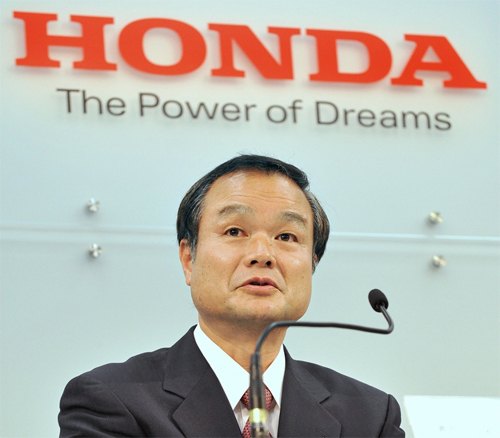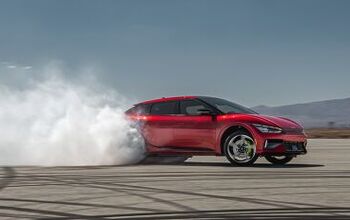Honda On Direct Injection: Don't Wait For It; We Have Other Priorities

Last week, in our post on Hyundai’s new DI (Direct Injection) Theta II engine, we questioned Honda’s long-standing engine technology leadership. We also assumed (wrongly) that they would be joining the DI club shortly, given the advantages DI technology affords. Turns out we weren’t the only ones wondering, except that in the case of auto, motor und sport, they weren’t asking it rhetorically, but the person in the know: Honda CEO Takanobu Ito. In an interview with Europe’s leading car magazine (print edition), Ito gave DI a pass with his answer to the question: “Honda was once the leader with its internal combustion engines. Did your competitors overtake you with gasoline Direct Injection?”
We have limited resources, and we are concentrating on Hybrids. We want to build the optimal engines for hybrids. And if we’re going to talk about hybrids, we have to talk about the costs for the consumer. Hybrids are very expensive. The fact that our hybrids (Insight) are selling so well in Japan is because of government incentives.
Well, the part about why the Insight is selling well in Japan was refreshingly candid, given its poor sales in the US versus the Prius. Ito goes on to share the dilemma facing Honda (and presumably others) in dealing with tightening efficiency demands and expectations:
One option would be to make cars smaller and lighter. But the consumer will not accept any compromises in comfort. So given the demands to reduce CO emissions and the expectations of continued gas price increases, adopting hybrid technology (further) is simply easier.
Just one problem with that, as we see it: why is Hyundai implementing both DI and hybrid technology?

More by Paul Niedermeyer
Latest Car Reviews
Read moreLatest Product Reviews
Read moreRecent Comments
- Dr.Nick What about Infiniti? Some of those cars might be interesting, whereas not much at Nissan interest me other than the Z which is probably big bucks.
- Dave Holzman My '08 Civic (stick, 159k on the clock) is my favorite car that I've ever owned. If I had to choose between the current Civic and Corolla, I'd test drive 'em (with stick), and see how they felt. But I'd be approaching this choice partial to the Civic. I would not want any sort of automatic transmission, or the turbo engine.
- Merc190 I would say Civic Si all the way if it still revved to 8300 rpm with no turbo. But nowadays I would pick the Corolla because I think they have a more clear idea on their respective models identity and mission. I also believe Toyota has a higher standard for quality.
- Dave Holzman I think we're mixing up a few things here. I won't swear to it, but I'd be damned surprised if they were putting fire retardant in the seats of any cars from the '50s, or even the '60s. I can't quite conjure up the new car smell of the '57 Chevy my parents bought on October 17th of that year... but I could do so--vividly--until the last five years or so. I loved that scent, and when I smelled it, I could see the snow on Hollis Street in Cambridge Mass, as one or the other parent got ready to drive me to nursery school, and I could remember staring up at the sky on Christmas Eve, 1957, wondering if I might see Santa Claus flying overhead in his sleigh. No, I don't think the fire retardant on the foam in the seats of 21st (and maybe late 20th) century cars has anything to do with new car smell. (That doesn't mean new car small lacked toxicity--it probably had some.)
- ToolGuy Is this a website or a podcast with homework? You want me to answer the QOTD before I listen to the podcast? Last time I worked on one of our vehicles (2010 RAV4 2.5L L4) was this past week -- replaced the right front passenger window regulator (only problem turned out to be two loose screws, but went ahead and installed the new part), replaced a bulb in the dash, finally ordered new upper dash finishers (non-OEM) because I cracked one of them ~2 years ago.Looked at the mileage (157K) and scratched my head and proactively ordered plugs, coils, PCV valve, air filter and a spare oil filter, plus a new oil filter housing (for the weirdo cartridge-type filter). Those might go in tomorrow. Is this interesting to you? It ain't that interesting to me. 😉The more intriguing part to me, is I have noticed some 'blowby' (but is it) when the oil filler cap is removed which I don't think was there before. But of course I'm old and forgetful. Is it worth doing a compression test? Leakdown test? Perhaps if a guy were already replacing the plugs...


































Comments
Join the conversation
"There’s an IP royalty to pay on any Gasoline Direct Injection technology, either to Orbital Engine Company (of Australia) or other players. " I don't think there is a royalty on the high-pressure system used in all production DI models now. Those inject fuel only. The lower pressure Orbital system injects fuel with compressed air, which expands and breaks up the fuel into smaller droplets (8-microns). I think the royalty charged by Orbital is based on the size of the engine. A wild guess for an auto size engine is $50. I think Orbital charges about $8 to $10 for the scooters and small motorcycles that use its system, and more for the outboard engines (Mercury, Tohatsu, Nissan). Saab was all set to put out a car with the Orbital system several years ago, but GM bought out Saab and canceled the plans.
Honda already has their own GDI engines in the Japan market Stream. So they have the technology and they can bring it out anytime they want - but if they think that they can do without GDI, then we'll just wait and see, since they can pretty much do lean burn with iVTEC already.